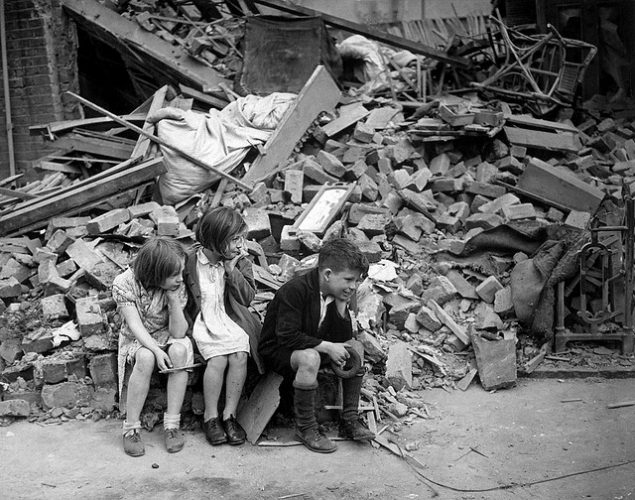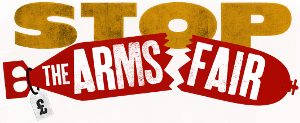David Rosenberg is a writer, educator and tour guide.He runs the East End Walks which explore London radical social history. He is the author of ‘Battle for the East End‘ (Five Leaves Publications, 2011) and ‘Rebel Footprints: a guide to uncovering London’s radical history’ (Pluto, 2015).

The start of the week of action against the DSEI arms fair coincides with a grim anniversary for relatives of people who were living and working in the area of the Royal Victoria Docks 75 years ago. But the history of militarism and resistance which is today embodied in the DSEI arms fair goes back to World War One. As thousands of people plan to take action in the next two weeks to stop the arms fair, it is worth remembering how the area that hosts one of the world’s biggest arms fairs has been impacted by war.
Saturday 7 September 1940 was the first night of the London Blitz, is remembered locally as “Black Saturday”. It was the night that saw the heaviest bombing on the docks area. Hundreds of lives were lost, and many homes and workplaces were destroyed.
This was not the first time that the docks, which stretched for miles east of the Tower of London, had been treated as a strategic target. Dock communities had suffered heavily also during the First World War. Many homes were devastated and one bomb landed on a school.
It was ironic that East London suffered disproportionately from military activity because compared with other London boroughs at that time, its political activists were disproportionately involved in campaigns against that war and against militarism, arguing instead for peace and internationalism.
Two inspiring political movements were at the heart of these campaigns locally. One was the Independent Labour Party (ILP), which won its first MP in West Ham in 1892, and established solid foundations in the area. The ILP gained another MP in Bow and Poplar from 1910-1912 – George Lansbury – and he later played a key role in coordinating anti-war activity. The other movement was the East London Federation of Suffragettes (ELFS) – an overwhelmingly working class suffragette body that took a very different stance on the war from its much more middle-class dominated West End counterparts.
West End suffragettes almost completely shut down their activities during war time; changed the name of their newspaper from The Suffragette to Britannia (!), became active participants in the drive for conscription. They tried to shame opponents of the war, and helped recruit women for munitions factories. The ELFS, meanwhile stepped up their fight for women’s rights, equal pay, equal opportunities during wartime and provided a lot of practical support for local women who were in a precarious economic position during the war. But in terms of expressing their anti-war politics, they faced a difficult situation. The husbands and brothers of many of the local women whose support they had won had gone off to fight, but as the war dragged on the ELFS became more confident in asserting their anti-war position through their newspaper, the Woman’s Dreadnought and on public platforms.
Another heterodox suffragette body – the Women’s Freedom League – which had a branch in East London, adopted a pacifist stance during the war.
War was declared at the end of July 1914, but in the few days before Britain had been dragged into it , the Daily Herald League, led by George Lansbury, together with other socialists and progressives, called a rally in Trafalgar Square. Huge contingents led by trade unionists marched all the way from the East End to this rally, which spilled over into the Strand and Whitehall as Trafalgar Square was completely packed.
When Britain entered the war a few days later, significant trade union leaders did a volte-face and then became patriotic enthusiasts for it, but Lansbury and the ILP stuck to their guns – or rather their opposition to guns – and continued to campaign both against the war and the militaristic ideology which fed it. In 1915 Poplar ILP held regular open meetings at the Dock gates campaigning against Government plans to bring in forced conscription. When the Government did, indeed, bring in that legislation in 1916,many men in West Ham and other East London boroughs such as Bow and Stepney were brought before tribunals for acts of refusal to join the military machine. Several of them ended up in prison.
Prison cells were also filling up with activists campaigning on the streets against conscription and war. Among them was Millie Witkop, an immigrant Jewish anarchist and sweatshop worker who lived in Stepney. She had come from the Russian Empire, and the Jewish immigrants who had fled dictatorship, discrimination, persecution and violence under Tsarist rule were particularly reluctant to sign up for an army that was in alliance with that Tsar.
When the Russian Revolution happened in 1917, it was especially welcomed by the immigrant East End communities and also by other socialists locally. Sylvia Pankhurst, a leading figure in the ELFS, had helped transform the organisation to the Women’s Suffragette Federation and then the Workers Socialist Federation. They campaigned amongst local workers to resist attacks on the fledgling Soviet Republic. In 1920, Their campaigning helped East London dockworkers decide to strike and refuse to load weapons on to ships, as these were intended for use against the Soviet Republic.
So in the next two weeks, as we unite in resistance to militarism embodied in the DSEI arms fair at Royal Victoria Docks, we remember those East Londoners who lost their lives to the bombers, warmongers and conscriptors, and we stand proudly in the tradition of ordinary East Londoners who refused to support militarist ideology and its escalating wars.



Amazing to read the history behind the arms trade and who was bombed and why. We all need to know the truth behind all conflicts. I have long suspected that the emerging middle class quickly support the right wing of politics as it gives them more credence in their work positions and their asset values.